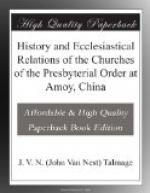We had already adopted the order and customs of our Church at home, so far as they could be adopted in an unorganized Church. The English Presbyterian brethren had adopted the same. They found that there were no differences of any importance between us and them; the churches being gathered under our care and under theirs—growing out of each other and being essentially one—neither we nor they could see any sufficient reason for organizing two distinct denominations. Especially had we no reason for such a course, inasmuch as they were willing even to conform to our peculiarities. We most cordially invited Mr. Douglas to unite with us in the organization of the Church, and he as cordially accepted of the invitation.
In reference to this subject Mr. Douglas wrote to their Corresponding Secretary as follows: “I need hardly say that this transaction does not consist in members of one church joining another, nor in two churches uniting, but it is an attempt to build up on the soil of China, with the lively stones prepared by the great Master-builder, an ecclesiastical body holding the grand doctrines enunciated at Westminster and Dort, and the principles of Presbyterian polity embraced at the Reformation by the purest churches on the continent and in Britain; it will also be a beautiful point in the history of this infant Church that the under-builders employed in shaping and arranging the stones, were messengers of two different (though not differing,) churches in the two great nations on either side of the Atlantic.”
The course of Mr. Douglas met with the decided approval of their Secretary, and, as he had reason then to believe, and has since fully learned, with the approval of their Church.




